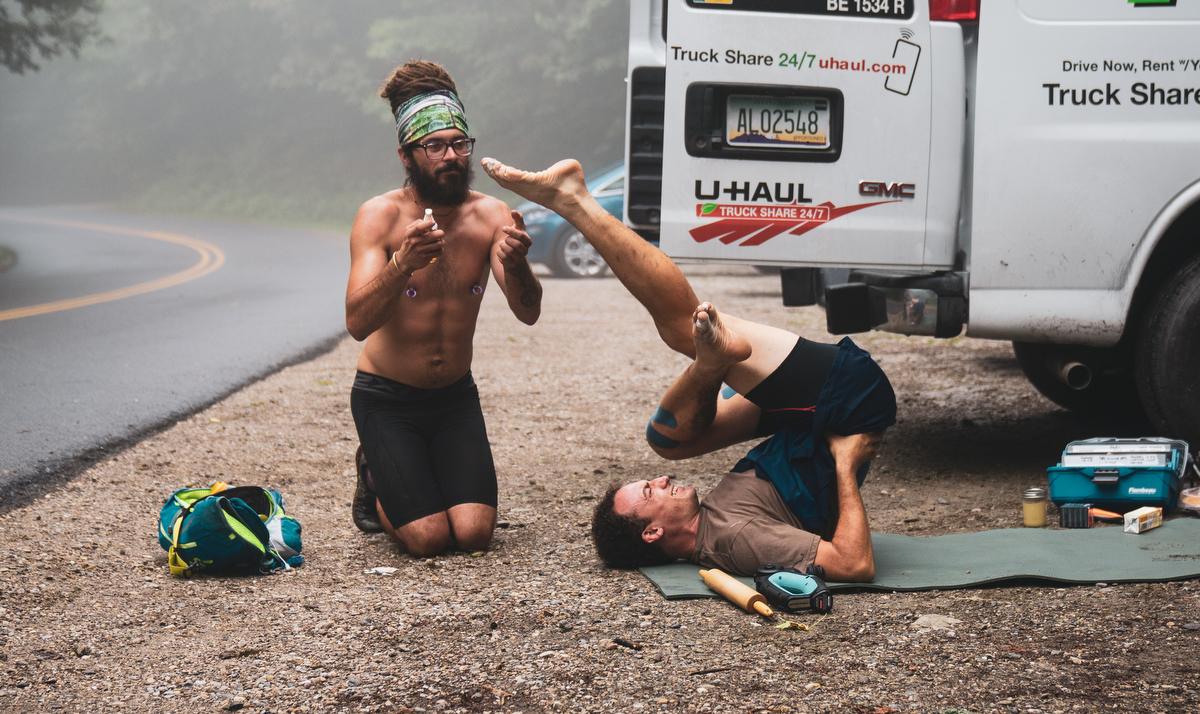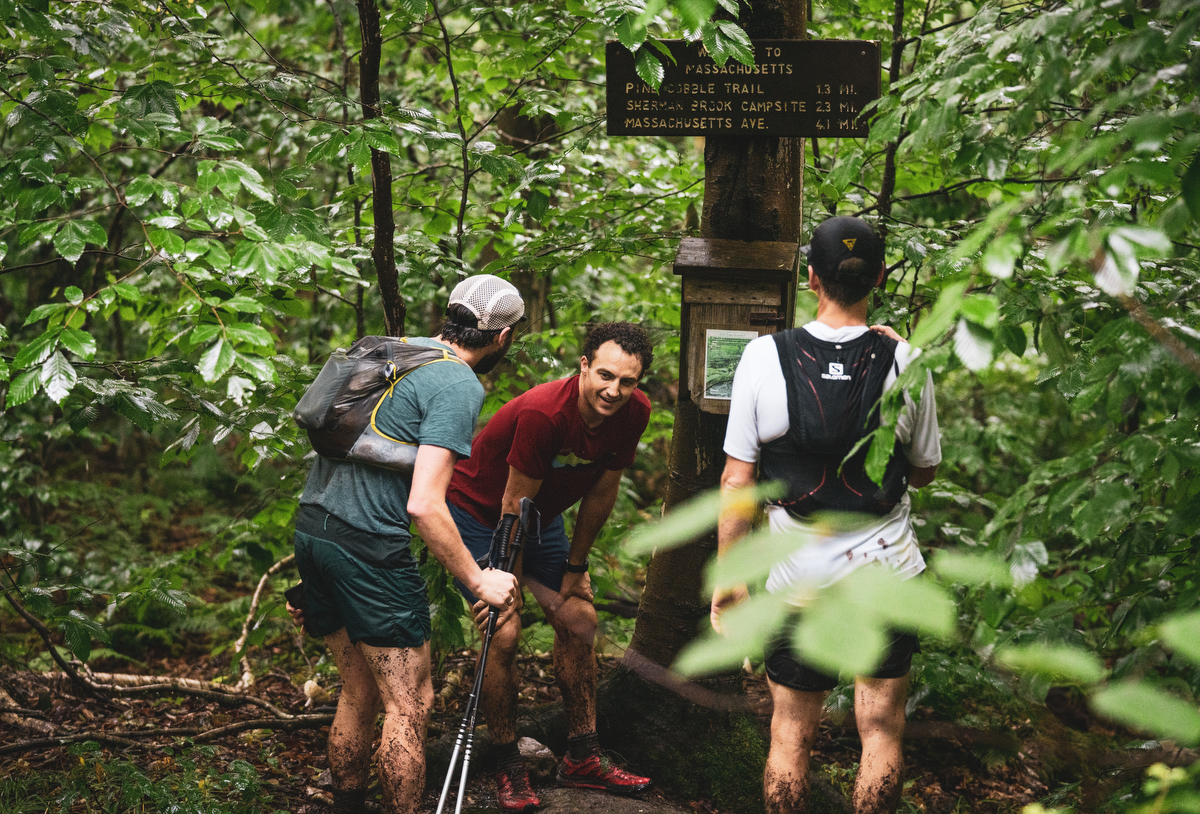On July 14, 2021, Ben Feinson set a new men’s supported fastest known time (FKT) on Vermont’s Long Trail. The oldest long-distance hiking trail in the United States, the Long Trail stretches between the Canadian border just outside of Jay State Forest and Green Mountain National Forest at the Vermont-Massachusetts border. Running the length of Vermont, the trail is rocky, root-covered, and often muddy — a classic and challenging U.S. East Coast trail. Feinson completed the route in 4 days, 11 hours, and 44 minutes, besting Johnathan Basham‘s record of 4 days, 12 hours, and 46 minutes from 2009 — improving the men’s supported FKT by a little more than one hour. In this interview, Ben talks about his effort, his awesome crew, what drew him to the FKT, and his love for deceptively challenging East Coast trails.

Ben Feinson crossing a bridge during his men’s supported Long Trail FKT effort. Photo: Lance Pitcher/@lancepitcher
iRunFar: Could you start off by telling us about yourself, what you do, and how you got into trail running?
Feinson: Well, I really started running in high school when I joined the cross-country team, because all my friends were joining the cross-country team. When I graduated from high school, my best friend Owen and I decided to hike the Long Trail together. I think that was the start of the distance hiking, the ultrarunning kind of inspiration was there for sure.
iRunFar: How long did it take you to hike it that first time?
Feinson: When Owen and I first hiked the Long Trail, I think we did it in 20 or 21 days. We thought we were awesome, you know… I like gnarly trails. The gnarlier the trails, the better… I haven’t actually run that many races. Maybe five or six real organized ultramarathons. Most on the East Coast.
iRunFar: Yeah, East Coast trails are gnarly. Do you have a favorite place to run?
Feinson: Oh goodness. That’s, that’s a difficult question because I’m so loyal to the East Coast, and I could spend my whole life hiking on the trails here in the Green Mountains. But having lived in Southern California, there are some big granite peaks that are really fun to run out there. And it’s just a whole different story, being up at high elevation.

Ben stretches out while a crew member provides moral support. Photo: Lance Pitcher/@lancepitcher
iRunFar: What made you want to pursue the men’s supported Long Trail FKT?
Feinson: It started in Boy Scouting, because we had backpacking merit badge, and we would do a 50-mile hike over a week with the boys. And they told us about Cave Dog [Ted Keizer], who had the Long Trail fastest time and how someone had run this trail in four days, and I couldn’t believe it… When I started my first [ultrarunning] events, it was in the back of my mind. I feel like any Vermont ultrarunner kind of wants to know how fast they can do the Long Trail. And it’s just one of those things that every year since 2017 I would draw a little plan for the Long Trail. This year just happened to be the right year for it.
iRunFar: I’m sure you’ve run sections of [the Long Trail] before but prior to this year, have you ever run the length of it without officially trying to go for the FKT?
Feinson: No, I’ve never I’ve never done a multi-day fast run like this before, so it was totally new. I think the furthest I’ve gone before this was 100 miles. I’ve hiked many sections of the trail many times. And this is the second time I’ll have gone through the whole thing.
iRunFar: Awesome. How did you go about preparing for it, crew wise? I’m sure your coach was on your crew, Joe [“Stringbean” McConaughy]?
Feinson: I don’t want to fill up all your time. I could talk about these folks forever.
iRunFar: You can talk as long as you want!
Feinson: The crew [including Joe] was the reason that the attempt succeeded. And I knew who was going to be on this crew for a year beforehand. My friend Owen and my lifelong hiking partner was also certain to be with me for this. He’s the one who originally hiked the Long Trail. Those ultrarunning buddies were Prem, Theresa, Maya, and Rob. And Owen was also the other crew leader, along with Prem, they kind of took charge. I’ve been planning with them for months and months. We’ve been just talking about it, sharing Google Sheets, and studying the map. We were also joined by a couple other pacers, Lance, Nick, and Jesse, who were huge in helping our crew, too. [My parents Jim and Lyn were also a very important part of my team.]

Ben and his crew, very muddy after completing the final miles of the men’s supported Long Trail FKT. Photo: Lance Pitcher/@lancepitcher
iRunFar: What about the trail itself? I assume it’s a typical East Coast trail, very rocky, rooty, and muddy. How were the conditions?
Feinson: Having spent some time in a few different areas, I can definitely say the Long Trail, and some of the New England trails, are the most technical I’ve ever been on. And especially when it’s been raining in Vermont, the roots and rocks can combine with rivers of mud that make it just a really huge challenge in a few different ways. You know, when they built this trail they just went straight over every peak in the Green Mountains, that they could. So it’s definitely really hard, even the downhills. When you look at the elevation profile, you think you might go quickly. The the trail is often just really, really technical scrambles, so you have to be experienced on this particular type of terrain to move quickly on it.
iRunFar: Were there any particular sections that were more difficult than others?
Feinson: Yeah, absolutely. I think most folks who have hiked through Vermont have hiked through the Appalachian Trail and the southern miles are much smoother, with less elevation gain than the northern miles. The northern half are really, really hilly with lots of taller peaks, at least for Vermont standards, 4,000-foot peaks. And it’s much more technical up north especially. I think folks who have gone for the FKT like Jeff Garmire and Joe have really been shocked by the difficulty of Mount Mansfield, Bolton, and White Face because they are technical, for sure.
iRunFar: How did you go about fueling for this? Different people’s stomachs hold up differently. Did you do a mix of real food, gels, and liquid calories, or how did you go about it?
Feinson: I like the story about fueling because the most I’ve ever fueled for was a 24-hour push a couple times, and I brought what I would bring for that, which was a combination of junk food and some whole food, that is, chips, and sweets and stuff, combined with some quesadillas, soup, potatoes, and bacon. But as I went along, two of the really experienced members of my group, Prem and Lance, helped coach me to eating more substantial, whole, nutritious food, and that was a huge.

Ben sitting in a chair for a rest during his men’s supported Long Trail FKT effort. Photo: Lance Pitcher/@lancepitcher
iRunFar: How did you go about sleeping? Did you take multiple little naps, or was there at least one night where you got a good, five, six hours? How was that?
Feinson: I think the goal was to get at least three hours every night. And the first night I got four which was a huge win, because we were a little bit ahead of schedule. The second night was three hours, as we had planned, right on schedule. But then the next night, I had set aside about two and a half or three hours to sleep. But I had some pain in my knees and my hips, and I just couldn’t sleep. I dozed maybe for an hour before getting up and starting a bit early. And then the fourth, the last night, we ran through the night and I took a couple 10- to 17-minute naps. My friend is really fond of the 17-minute nap, he thinks it’s the perfect time. It wasn’t until the last night, and pushing into the next day, where I was so exhausted that I could just fall asleep on a dime. I remember the morning, at dawn, before the last 12-hour push on day five, I sat down in a chair right next to the crew’s van at the Stratton Arlington Road, and set my watch for 10 minutes, and in the sun in the chair just passed right out.
iRunFar: How was the weather? Did you get a lot of storms? Are there regular storms that roll through Vermont around this time of the year?
Feinson: Our weather isn’t quite as regular as out West with how the storms work, so it’s hard to predict, but we got so incredibly lucky. The first three days were cool and dry. For July, that’s almost unheard of. That was a huge factor in getting through the gnarly sections of the trail without water. The rockier peaks is a huge deal. But the night after the third day, it started raining. And it rained really hard when we were climbing over Killington Mountain, which is kind of the start of the southern miles. It poured and poured on that mountain, and then the next day, there was a short but torrential downpour. For the rest of the hike, the whole trail was soaked. Really deep mud in a lot of places, and just constant wet feet.

Ben with crew members at the end of his men’s supported Long Trail FKT effort. Photo: Lance Pitcher/@lancepitcher
iRunFar: So you got the men’s supported FKT, but you were that you were within an hour, right? It was about an hour faster. Was there a point when you knew that you had it in hand or did you have to really keep pushing hard till the end?
Feinson: What’s odd is, I think that I was certain, and a couple of my crew members were certain, that we had the [men’s supported] FKT, at a point where most people watching would not have agreed. I basically quit the last evening. They pulled me back, we kind of re-attacked our effort, reset the clock, and said, we have 24 hours to do 72 miles. But after that I pushed through that last night in the Stratton Wilderness successfully with Prem, who did an insane number of very difficult miles with me. He hiked almost half the trail. When we got back to camp, or to the next junction, and met Lance at dawn, he and I had to do a really hard 37 miles to finish the effort. I was convinced that we had it even though it was going to be a grueling 12 hours. I was totally convinced and we just kept up the pace, and didn’t crash. And the last 14 miles, running in with six people, my whole crew through this awful mud and thunderstorm was probably the best run of my life.
iRunFar: Congratulations and thank you!
[Editors Note: This interview has been edited for brevity and clarity.]
